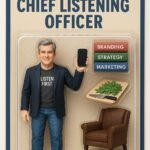A guest post by Megan Hudson on The Marketing Sage about customers and their mindset
“Think like a customer.” – Paul Gillin
The modern age of commerce is known among businesses as the ‘age of experience.’ The advancement of digital technology has changed the way brands conduct business, prompting them to provide an optimal customer experience to stay competitive.
Today’s customers and consumers have more access to information and alternatives than ever before. Accessibility means that it’s vital for savvy brands to do whatever they can to remain front and center in their target market’s minds, especially if they want to keep customers and consistently attract new leads.
As digital technology and eCommerce continue to expand and develop, the contest to win consumer headspace is becoming increasingly competitive. Brands that can’t form lasting emotional bonds with their customers don’t have the same level of staying power that more mindset-focused brands do.
Targeting customers’ mindsets are the key to creating as many positive customer experiences as possible.
The Complex World of Customer Mindset Data Science
“The customer’s perception is your reality.” – Kate Zabriskie
Brands that wish to optimize their customers’ experiences need to understand their customers’ needs profoundly and meaningful.
They need to dive beyond the surface of the customer experience and find out exactly what drives their target market, what they want in life, what pleases them, and what disappoints them.
This data should form the basis of any comprehensive marketing strategy in the modern age. Once you’ve gathered this information, your marketing team will also need to stay updated with changes to these customer expectations and desires through consistent and deliberate research.
Understanding your customers’ mindsets at any point in time is equally crucial to understanding customer behavior.
Mindset drives consumer behavior, and research has shown that customer mindsets significantly impact purchasing decisions. It’s important to note that mindsets can change from day to day or from hour to hour, depending on the situation.
For example, one customer might find themselves feeling relaxed and impulsive on a Saturday evening while browsing your eCommerce store. The next day, they may feel stressed out about having to return to work on Monday. These feelings will lead them to behave entirely differently than they did on Saturday, navigating through your site quickly and unpredictably to find the products they need.
Every single customer that interacts with one of your brand’s touchpoints will leave behind hints about their mindsets. Their scrolling patterns, mouse movements, zooms, taps, and items added to the cart all paint a picture of that customer’s so-called digital body language at any given time.
If you can gather this form of data, you can adapt your customer experiences according to the unique mindsets of your customers. This approach will ensure that you tailor your CX to all mindsets and provide your customers with what they genuinely want.
Five Analytic Tools
Here are the five experience analytics tools your marketing team can use to understand your customers’ mindsets better.
1. Buyer Personas
A buyer persona is often used as a strategic marketing tool that creates your ideal customer profile. It usually consists of an avatar with an individual name and backstory. This profile doesn’t necessarily reflect your typical customer, but it should be based on fundamental research into what your customers expect from your brand.
Creating a buyer persona should involve primary and secondary research. You can use the internet to research relevant studies and statistics about the types of customers you want to address. This research will give you data about trends and bigger-picture references to work with, which in turn gives you a valuable strategic starting point.
Your marketing team should gather data from the people who frequently work with your target demographic, as well as your customers, prospects, and sales representatives. Genuine customer reviews are one of the most valuable tools for understanding the customer mindset.
2. Journey Mapping
Journey mapping is the marketing practice of detailing a customer’s path to purchase. This practice aims to describe the steps your ideal customers will take as they progress from needs awareness, research, and consideration to purchasing your products.
You can use your data gained through customer surveys and personal development to plan your journey maps.
3. Surveys and Customer Focus Groups
Surveys and focus groups can provide you with a broad and specific set of data on your target market. These tools can assist you in developing better personas and gathering valuable statistics about how your target market views your brand, how they see you in comparison with your competition, and how other customers influence them.
Focus groups also provide you with information about the differences between consumer demographics and how your company is performing in line with their expectations.
A great example of the power of surveys comes from a study conducted by the Rice School of Business. The study revealed that just taking a study influenced how customers felt about a product. By filling in details, they cemented their future relationship with a brand. Surveys are only valuable for businesses looking to improve, making them an excellent marketing tool.
4. User and Usability Tests
User/usability testing aims to assess the mindsets of customers as they visit and use eCommerce websites. User tests are a great way to gauge the reactions and opinions of a target market and explore customers’ minds concerning your website or mobile app experience.
User testing will let you know if your customers need a feature, and usability testing displays how well they can use it.
5. Data Analytics
Analytics can assist your brand in continuously reassessing and understanding customer behavior. Tools like Google Analytics and CRM solutions deliver quality data that marketers can use to generate actionable audience insights.
Your first step should be to identify the metrics that are most crucial to your efforts and goals, gaining insights from these statistics, and using them to make informed marketing and operational decisions.
How to Use Mindset Data to Meet Customer Needs
“Get closer than ever to your customers. So close, that you tell them what they need well before they realize it themselves.” – Steve Jobs
Data is an invaluable tool for gauging customers’ mindsets and tailoring your company’s customer experience accordingly. These tips can help.
- Create a cross-functional data team that understands the key challenges facing your organization and can use data to solve them.
- Collate the right kinds of data. Don’t neglect millisecond-level customer experience data like hovers, scrolls, and clicks of a mouse across your site. Your data team can use experience analytics to analyze this data and offer insights and heatmaps into how your customers use the individual aspects of your digital experience and your brand.
- Focus on the mindsets and buying behaviors of your best customers. Assess their engagement with your platforms and the actions they take when they shop with you. Do they spend time on your site or leave after a few minutes? Are they skipping over the essential parts of your product pages? Gather answers to these questions and make gradual, targeted changes to your digital touchpoints to enhance the customer experience.
- Align customer mindset data with your business. Your data team should feed valuable insights to all the proper departments in your business at the most reasonable times and in the correct formats. This alignment will allow customer service, marketing, product development, and even your board to work together to align their offerings with your customers’ demands.
- Measure and learn from changes over time. It would be best if you were willing to adapt to your customer’s ever-changing needs and mindsets to provide them with a satisfactory, data-backed experience with your brand. Assess the success of each strategy you implement and be willing to change your approach if the results do not further your business’s goals.
Make The Connection, and Make It Last
“If you’re not listening to your customers, your competitors are.” – Leela Srinivasan
Your brand needs to look beyond the customer experience and analyze its customers’ mindsets to create lasting emotional connections with its target audience.
Use data analytics, surveys, focus group analyses, journey maps, and buyer personas to put yourself in your customers’ shoes and design an experience that truly meets their needs and expectations.
Megan Hudson is a content champion for various online publications, often covering multiple business topics from finance for startups, pop culture, and small business accounting tips.
Photo by David Matos on Unsplash




